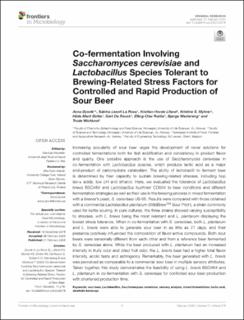| dc.description.abstract | ncreasing popularity of sour beer urges the development of novel solutions for controlled fermentations both for fast acidification and consistency in product flavor and quality. One possible approach is the use of Saccharomyces cerevisiae in co-fermentation with Lactobacillus species, which produce lactic acid as a major end-product of carbohydrate catabolism. The ability of lactobacilli to ferment beer is determined by their capacity to sustain brewing-related stresses, including hop iso-α acids, low pH and ethanol. Here, we evaluated the tolerance of Lactobacillus brevis BSO464 and Lactobacillus buchneri CD034 to beer conditions and different fermentation strategies as well as their use in the brewing process in mixed fermentation with a brewer’s yeast, S. cerevisiae US-05. Results were compared with those obtained with a commercial Lactobacillus plantarum (WildBrewTM Sour Pitch), a strain commonly used for kettle souring. In pure cultures, the three strains showed varying susceptibility to stresses, with L. brevis being the most resistant and L. plantarum displaying the lowest stress tolerance. When in co-fermentation with S. cerevisiae, both L. plantarum and L. brevis were able to generate sour beer in as little as 21 days, and their presence positively influenced the composition of flavor-active compounds. Both sour beers were sensorially different from each other and from a reference beer fermented by S. cerevisiae alone. While the beer produced with L. plantarum had an increased intensity in fruity odor and dried fruit odor, the L. brevis beer had a higher total flavor intensity, acidic taste and astringency. Remarkably, the beer generated with L. brevis was perceived as comparable to a commercial sour beer in multiple sensory attributes. Taken together, this study demonstrates the feasibility of using L. brevis BSO464 and L. plantarum in co-fermentation with S. cerevisiae for controlled sour beer production with shortened production time. | |
